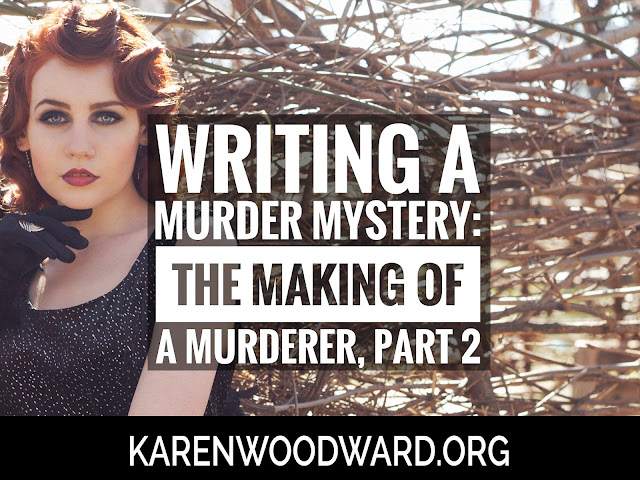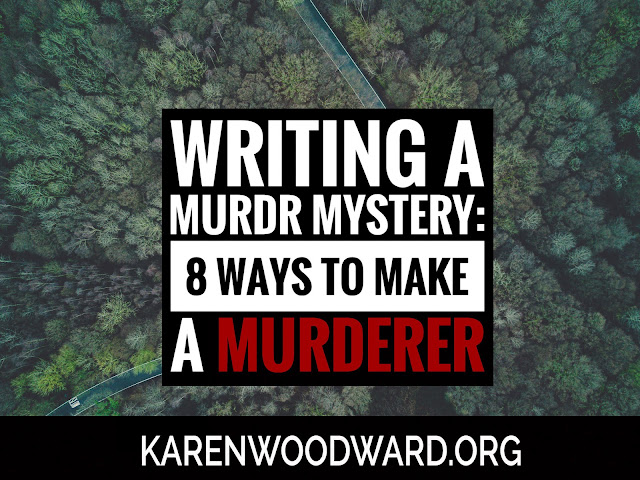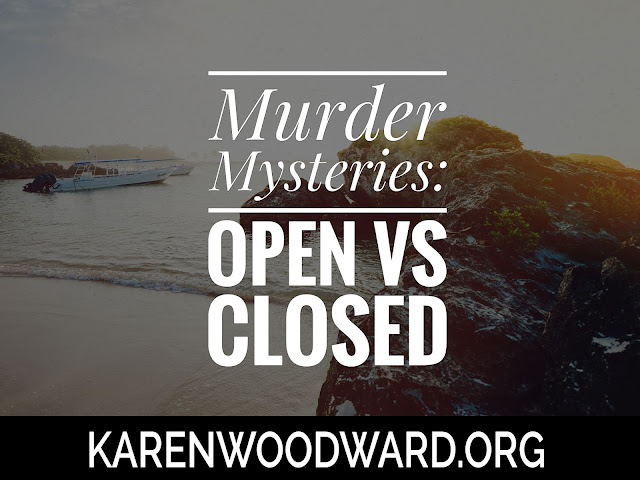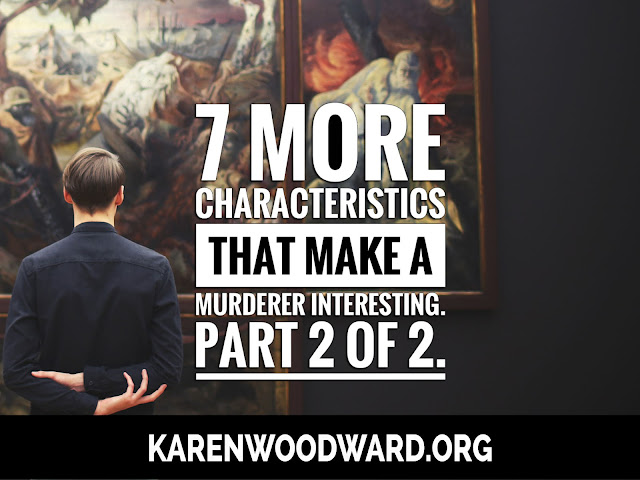Yesterday I began fleshing out a character, the murderer, for a murder mystery I'm tentatively calling Murder in Meadowmead. Today I pick up where I left off yesterday (The Making of a Murderer).
Note: I've included this material in my book, How to Write a Murderously Good Murder: The Major Characters.
2. Differentiate the murderer’s motivation from his/her goal.
a. How does the murderer’s motivation resolve into a concrete goal?
As we saw yesterday, the murderer, Lydia, is motivated by her twisted love for her husband, Mark. Her goal, on the other hand, is to murder her father and brother. Let’s break this down.
Motivation --> goal: Lydia (incorrectly) feels that the only way to keep her husband is to acquire large amounts of money. The only way she can do this in the near future is to inherit her family’s wealth. Unfortunately for them, the only way this would happen is if her father and brother were no longer among the living. Therefore Lydia decides they must die.
b. How does the murderer’s motivation show their passion?
The murderer’s motivation (keeping Mark) IS Lydia’s passion. She is head-over-heels in love with Mark. But it’s an unhealthy, immature, love. Mark is the ONLY person she cares about, he is a splash of color in a world of grey. (In other words, the murderer has bigger problems than losing Mark, but she has no idea of this.)
3. What is the murderer’s goal?
The murderer passionately wants to keep something: her husband. Yes, she wants vast sums of money, but she wants the money because she wants to keep her husband.
(Perhaps it will turn out that Lydia is actually more attached to money than she tells herself. Perhaps she wants to think she just wants the money to keep Mark but she’s kidding herself. This is something we can explore down the road.)
a. What does the murderer love? Be specific.
The murderer loves her husband, Mark. She also cares deeply that her business is failing. It isn’t just the money, it bothers her that she wasn’t able to make a success of things, that her father is ashamed of her.
b. Why is the murderer passionate about attaining this particular goal?
There are many ways a particular motivation can be expressed, there are many ways it can resolve into a particular goal. What this question is asking is why did this particular murderer choose this particular goal?
In other words, why choose to go straight to murdering her family rather than do something else like stage a kidnapping or, less violent still, try to sell her failing business, or (despite what her father said) go and beg her father for more money. Why go straight to murder?
The answer is pretty clear: there’s something a bit off about our Lydia. Also, she’s not a big fan of her father and brother. My guess is that there’s a backstory we haven’t uncovered yet. How about ...
Her father didn’t treat Lydia very well when she was a child. He beat her and kept her isolated because he didn’t want her telling anyone.
A few people suspected what was happening at home but they didn’t want to get involved. Lydia’s father was wealthy and could have made a lot of trouble for anyone who spoke up. Her brother never beat her but he didn’t do anything to try and help her either.
4. Be merciless! Give the murderer a deep psychological wound.
a. What is Lydia’s deep psychological wound?
I think we’ve just found out what it is: childhood abuse. Lydia was beaten as a child and not allowed to interact with anyone but her father, brother and their servants. She wasn’t allowed outside unsupervised. Even when she was old enough to go to school they brought tutors in to educate her rather than let her go off on her own. After all, then they could never be sure who she Lydia talked to or what she had told them.
b. How is this deep psychological wound tied into Lydia’s strength?
Every significant character should have a strength, something concrete they’re good at. I know it might sound odd to put it like this, but they should have a characteristic that could help them win a bar bet.
I’m going to say that, because of the abuse she suffered, Lydia became hyper-observant. She’s a past master of Where’s Waldo. Also, ask her to tell what differs between two pictures and it only takes a glance for her to see it. Sometimes, though, she only knows that there IS a difference but she can’t see it. When this happens—and it doesn’t happen often—she becomes paralyzed, obsessed, until she is able to identify the difference. (And, yes, I’m shamelessly borrowing this from Mr. Monk and Sherlock!)
Another effect of her psychological wound, of the childhood abuse she suffered, is having to live with a feeling of isolation. She was isolated throughout her childhood and rarely felt the simple comfort of human touch, a hand on her arm, a quick hug. Consequently, she has an intense aversion to being touched (except for Mark). She can’t bear the touch of a stranger, it feels like ants crawling over her skin and her anxiety ratchets up into the stratosphere.
CHARACTERISTIC: Lydia can’t bear a stranger’s touch.
5. Let the murderer win occasionally.
a. How does the murderer get the upper hand? Give at least one instance where the murderer ‘wins.’
It might sound odd, but Lydia gets the upper hand by killing the brother first. Why? Because Lydia had no obvious motive for killing her brother. Also, for her brother’s murder she has a run-of-the-mill alibi, as one would. The night her brother died Lydia said she was making a new recorder and, when asked, her neighbors say they heard music coming from her workshop. This checks out and, since the detective is used to thinking of Lydia as innocent, this biases him in this direction when her father’s body is found.
CLUE: The night her brother died the weather was unseasonably cold. The only way the neighbors could have heard Lydia play is if she kept the window open.
CLUE: Lydia is quite thin and tends to get a chill. It doesn’t seem to the detective as though she would have left the window open on such a cool night.
Detective’s action: Detective asks Lydia what she was wearing. If she was bundled up then, fine. Sometimes you just want the window open to air out the place. After all, she was working. Perhaps she was sanding? If so, the open window makes sense. But if she WASN’T she may have left the window open because that was the only way the neighbors could have heard her music. It would be easy to set music to automatically play at a certain time.
The detective could say something like: “Say, this looks like a drafty old place. What do you spend in heating?” “Really! That much. My mom was always telling us to put on sweaters, I used to tell her I could tell when she was cold, she’d get me to put on a sweater! So, what do you do in the winter? This place must be cold. You like wearing sweaters? No? Well, that’s interesting.” Or something less lame!!! You get the idea. Just watch an episode of Columbo. He talks to suspects about completely irrelevant things ... or rather, things that seem completely irrelevant until he’s spun his web around the suspect.
6. How does the murderer attempt to mislead the detective?
At a certain point toward the end of the story all the clues will be on the table. The detective just isn’t seeing them in the right way. This will soon change. The murderer needs to at least TRY to spin the events. They need to have some sort of story that explains the murders, the clues gathered, but in a way that casts them as an innocent person. I think of this as the Janus Story, after the two headed god. The murderer is in the unique position of, throughout the entire story, knowing the truth but being driven to lie.
Lydia’s Janus Story: At the moment I’m not sure what this will be and that’s okay. It’s early. One idea is to bring in a touch of the paranormal. Lydia could try to get the detective to believe there’s some sort of a curse at work. If I don’t want to draw in the supernatural/paranormal I could perhaps try to pin the killings on a secret organization that the family had contact with.
Let’s explore each of these possibilities.
Secret Organization (SO)
I love reading stories about secret organizations! This secret organization can’t take over the story, it has to be kept in the background. I’m thinking that it’s something that would (for me) be exotic, something that originated in Asia thousands of years ago.
The reality is that Lydia’s family IS involved with this organization. Lydia stumbled across something, a clue, when she was a child, something she was beaten for. Perhaps a letter in her father’s desk. He had left his desk drawer unlocked intending to be out of his office only a moment. Lydia wandered in and saw something she shouldn’t have. A piece of paper. A letter with an odd looking symbol at the top. Lydia remembered the symbol.
Much later she had to do a book report on something-or-other, and came across that same symbol. The author was talking about a secret organization shrouded in mystery. She wrote her report then forgot about it. Now, casting about for an alternate explanation, an idea occurs to her.
MURDERER’S CHARACTERISTIC: Lydia saves everything. She has every book report she’s ever written, every essay she wrote.
Since Lydia is a hoarder she still has the book report she wrote and so I don’t need to worry about hiding her internet trail as she does research!
CLUE: Lydia knows she’ll need something substantial to tie her family to the secret organization (I need to think of a cool name!) and so visits her father’s place while he’s away on vacation. The problem is, he arrives home early and catches her there. She stammers a bit and comes up with what she hopes is a plausible reason for her presence. She hopes her father bought it. Later it turns out that although her father didn’t guess what she was up to he thought the event strange enough to mention to his attorney/friend. This was the last time Lydia saw her father but she keeps her mouth shut about it and doesn’t tell the detective. When the detective finds out from her father’s attorney that she met him at his place, that she was digging around there, that her father thought her presence was suspicious, the detective confronts Lydia about this.
QUESTION: What story would Lydia give the detective a) for why she lied to him and b) why she was there?
Okay, good progress! I’m going to shift gears now and think about whether Lydia should, instead, go with a paranormal explanation. I like the idea of having a secret organization, it feels fun, but let’s think about how we could spin a story of a curse.
Paranormal
My detective isn’t going to be in the least superstitious, but the murderer doesn’t know that.
I’m being inspired by the adaptation of Agatha Christie’s The Tragedy at Marsdon Manor. There the murderer, Susan Maltravers, makes it seem plausible she is seeing ghosts. In reality Susan is attempting to build a narrative that will scare her husband to death (this has a shot of working because he has heart trouble). When this doesn’t work she gets impatient and shoots him. Her Janus Story: The ghost scared him to death.
It could also be that Lydia’s family used to be part of a larger clan but has been plagued with unfortunate accidents. Now the clan has shrunk to contain only the three of them: Lydia's father, Lydia's brother, and herself. Her brother is unmarried and childless. She has no children. Her mother died at some point but I don’t know why.
QUESTION: Were Lydia’s father and mother still married at the time of her mother’s death?
QUESTION: How did Lydia’s mother die? That is, how did she REALLY die and how does Lydia think she died?
It could be that one of Lydia’s ancestors made a promise, one that her grandfather broke. Ever since then tragedy has befallen the family.
I think I like the secret organization angle better. That said, I could roll the curse explanation into the secret organization explanation. It could be that grand-dad did something to anger the secret organization of which they’re all a part. Perhaps even Lydia’s own actions are somehow (unbeknownst to her) occasioned by the secret organization. Perhaps they have been subtly influencing her. Perhaps that’s too exotic for a traditional murder mystery! Though perhaps I could dangle it as a possibility at the end.
(I just got back from the gym, while working out it occurred to me that Lydia’s mother discovered what was going on with her husband and the secret organization. Something happened when Lydia got into her father’s papers. Lydia’s father flew into a rage and her mother intervened to protect her child. Lydia’s father lost control and hit his wife. Taken unawares she fell backward, hit her head and died. Lydia’s father, unable to accept that he killed his wife (whom he loved) blamed his daughter.)
CHANGE: Lydia’s beatings began AFTER her mother’s death.
QUESTION: How old was Lydia when her mother died?
Answer: It has to be the case that Lydia remembers the symbol but young enough that we believe she doesn't have a vivid memory of the event. That is, it needs to seem plausible that she forgot the symbol of the secret organization was in any way tied to her mother’s death, etc. Let’s say 5 years old? 6 years old? (I don’t have children, so if any of you parents want to chime in here, please do!!)
DEEP DARK SECRET: This is another deep dark secret for the murderer. She will discover the truth about the symbol of the secret society and believe (incorrectly) that she was the cause of her mother dying.
CHANGE: This is more of an addition than a change, but ... Let’s have it that Lydia adored her mother. Her mother’s death was immensely traumatic for her. When she learns the truth about her mother’s death—and that she was indirectly the cause of it—she wants vengeance. This doesn’t change anything I’ve already said about Lydia killing her father and brother for the money, but it will make her father’s murder easier for her to carry out. We could say that she came across this information as she went through boxes in her storage locker, perhaps these were boxes of her mother’s things, boxes she hadn’t gone through before. (I just had the thought that perhaps it would be most dramatic if her father tells her this information just before she murders him.)
QUESTION: Why was Lydia going through her mother’s boxes now, at this particular time? What event occasioned this?
Okay! So far so good, we’ll leave that there for now.
7. Reveal the killer’s true face.
The killer has been hiding for most of the story. We haven’t been able to see her directly, we’ve peered at characters wondering: Is that him/her? Is THIS person a seething sea of madness under their mask of calm normality?
The reveal is the place to show the murderer as they truly are. And how do we do that? Put the character in a crucible.
a. At the end of the story how does the murderer reveal his/her inner nature? What do they say? What do they do?
I’m not sure. I think Lydia would be more on the quiet side. Perhaps she would cry, sob. Perhaps she would try to get Mark to understand why she had killed, why she had to kill. (Such behavior will repulse Mark.)
b. What does the character fear the most?
In Lydia’s case, she fears ... Well, what’s her trauma? She fears her father, she fears isolation. She has lived through isolation and she never wants to be that alone ever again. In a sense, her not wanting to lose Mark, her husband, is because she can’t be alone. For Lydia, hell would be solitary confinement. It would be the feeling that she is all alone and that is how she will be forever.
c. How does the murderer react to being unmasked? Does she become violent? Does she curse the detective? Does she try to make everyone understand why she did it, why she had to do it?
I think Lydia would abandon her dignity, break down, and beg Mark not to leave her.
8. What happens to the killer at the end?
a. How will you wrap up the killer's story? Do they go to jail? Are they killed? Do they (as Agatha Christie ended several of her books) take their own lives?
I’m not sure. I think this is something that will become clearer as the story progresses.
Every post I pick something I love and recommend it. This serves two purposes. I want to share what I’ve loved with you, and, if you click the link and buy anything over at Amazon within the next 24 hours, Amazon puts a few cents in my tip jar at no cost to you. So, if you click the link, thank you! If not, that’s okay too. I’m thrilled and honored you’ve visited my blog and read my post.
Today I’m recommending Revising Your Novel: First Draft to Finished Draft: A step-by-step guide to revising your novel, by Janice Hardy. I’ve read Janice Hardy’s blog for years and her advice is top notch.
From the blurb: “Award-winning author Janice Hardy (and founder of the popular writing site, Fiction University) takes you step-by-step through the novel revision process. She’ll show you how to analyze your draft, spot any problems or weak areas, and how to fix those problems.”
Okay! It looks like we’ve gotten through the making of a murderer! Yea!! If you’re following along and making your own murderer as we go I’d love to learn a bit about him or her. Did you discover her name? Her motive? Her backstory? Please share!! :-)
I’ll continue this series tomorrow and talk about the detective. Till then, good writing!!









